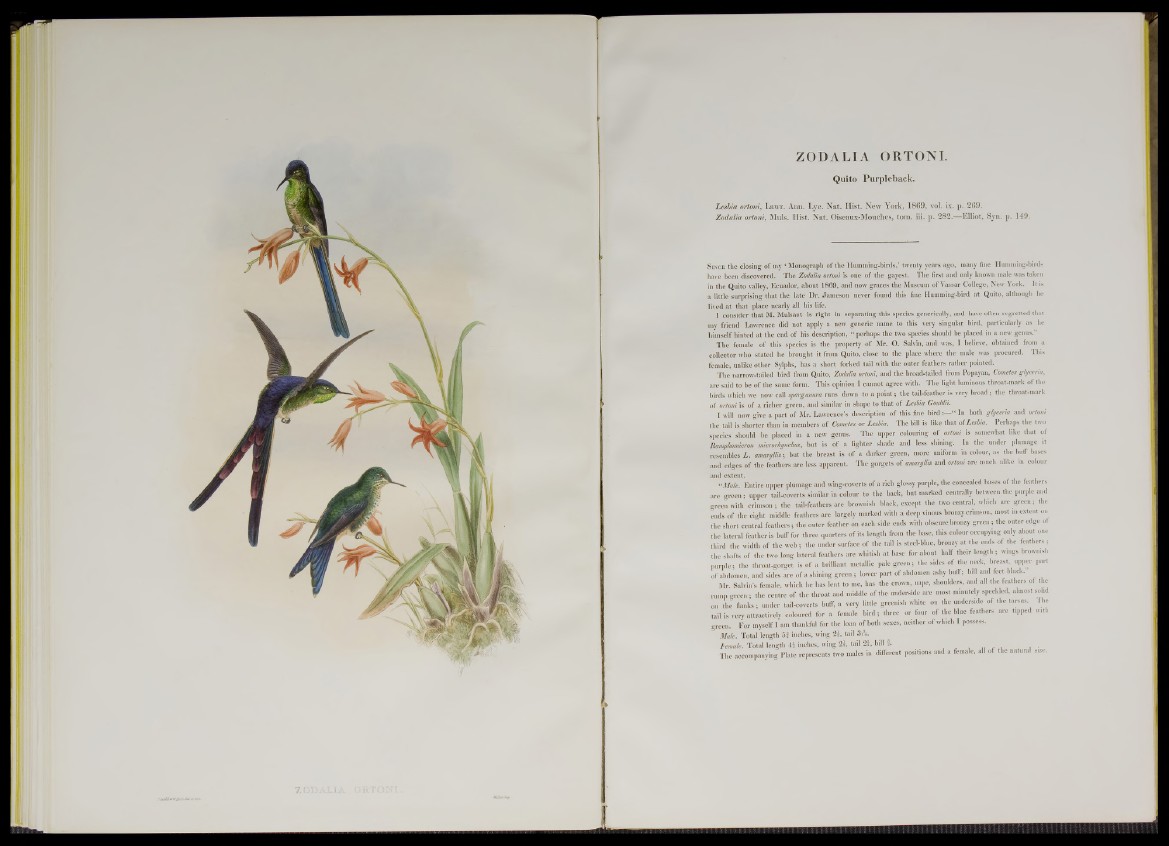
ZODALIA ORTONI.
Quito Purpleback.
Lesbia ortoni, Lawr. Ann. Lyc. N a t. Hist. N ew York, 1 8 6 9 , vol. ix. p. 2 6 9 .
Z o dalia ortoni, Muls. I lis t. N a t. Oiseaux-Mouches, tom. iii. p. 2 8 2 .— Elliot, Syn. p. 149.
S in c e the closing of my * Monograph of the Humming-birds,’ twenty years ago, many fine Humming-birds
have been discovered. The Zodalia ortoni is one of the gayest. The first and only known male was taken
in the Quito valley, Ecuador, about 1869, and now graces the Museum o f Vassar College, New York. It is
a little surprising that the late Dr. Jameson never found this fine Humming-bird at Quito, although he
lived at that place nearly all his life.
I consider that M. Mulsant is right in separating this species generically, and have often regretted that
my friend Lawrence did not apply a new generic name to this very singular bird, particularly as he
himself hinted at the end of his description, “ perhaps the two species should be placed in a new genus.”
The female o f this species is the property o f Mr. O. Salvin, and was, I believe, obtained from a
collector who stated he brought it from Quito, close to the place where the male was procured. This
female, unlike other Sylphs, has a short forked tail with the outer feathers rather pointed.
The narrow-tailed bird from Quito, Zodalia ortoni, and the broad-tailed from Popayan, Cometes glyceria,
are said to be o f the same form. This opinion I cannot agree with. The light luminous throat-mark o f the
birds which we now call sparganura runs down to a point; the tail-feather is very broad ; the throat-mark
of ortoni is of a richer green, and similar in shape to that of Lesbia Gouldii.
I will now give a part of Mr. Lawrence’s description o f this fine bird “ In both glyceria and ortoni
the tail is shorter than in members o f Cometes or Lesbia. The bill is like that aiLesbia. Perhaps the two
species should be placed in a new genus. The upper colouring of ortoni is somewhat like that of
Ramplomicron microrhynchus, but is o f a lighter shade and less shining. In the under plumage it
resembles L . amaryllis; but the breast is o f a darker green, more uniform in colour, as the buff bases
and edges of the feathers are less apparent. The gorgets of amaryllis and ortoni are much alike in colour
and extent.
"Male. Entire upper plumage anti wing-coverts of a rich glossy purple, the concealed bases of the feathers
are green; upper tail-coverts similar in colour to the back, hut marked centrally between the purple and
green with crimson; the tail-feathers are brownish black, except the two central, which are green; the
ends o f the eight middle feathers are largely marked with a deep vinous bronzy crimson, most in extent on
the short central feathers; the outer feather on each side ends with obscure bronzy green; the outer edge ot
the lateral feather is buff for three quarters of its length from the base, this colour occupying only about one
third the width of the web ; the under surface o f the tail is steel-blue, bronzy at the ends of the feathers ;
the shafts of the two long lateral feathers are whitish at base for about half their length ; wings brownish
purple; the throat-gorget is o f a brilliant metallic pale green; the sides o f the neck, breast, upper part
of abdomen, and sides are of a shining green ; lower part o f abdomen ashy buff; bill and feet black.
Mr Salvin’s female, which he has lent to me, has the crown, nape, shoulders, and all the feathers of the
rump green ; the centre of the throat and middle o f the underside are most minutely speckled, almost solid
on the flanks; under tail-coverts buff, a very little greenish white on the underside of the tarsus. I he
tail is very attractively coloured for a female bird; three or four of the blue feathers are tipped with
green. For myself I am thankful for the loan of both sexes, neither of which I possess.
Male. Total length 5 f inches, wing 21, tail 3 * .
female. Total length 4 i inches, wing 2 i, tail 2 i, h illi. j
The accompanying Plate represents two males in different positions and a female, all of the natural size.